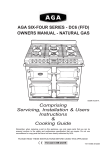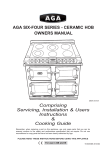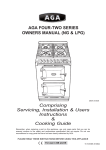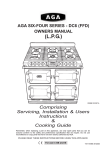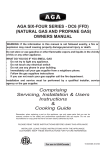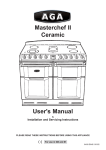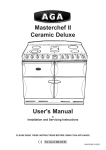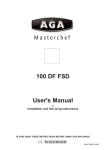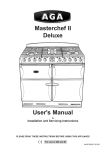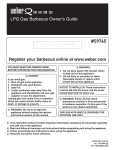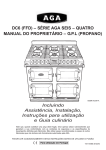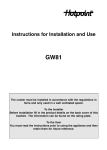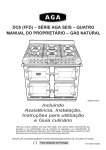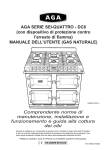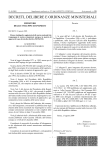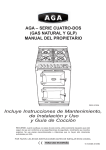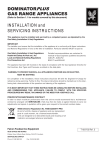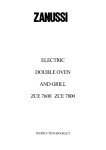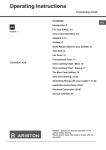Download AGA SIX-FOUR SERIES - DC6 (FFD) OWNERS MANUAL
Transcript
AGA SIX-FOUR SERIES - DC6 (FFD) OWNERS MANUAL DESN 512387 Comprising Servicing, Installation & Users Instructions & Cooking Guide PLEASE READ THESE INSTRUCTIONS BEFORE USING THIS APPLIANCE INSTALLER: LEAVE THESE INSTRUCTIONS WITH THE APPLIANCE CUSTOMER: KEEP THESE INSTRUCTIONS FOR FUTURE REFERENCE For use in Australia 05/13 EINS 514241 CONTENTS SECTION PAGE INSTALLATION SECTION 3 INSTALLATION TECHNICAL DATA FITTING AND PRODUCT DIMENSIONS ELECTRICAL CONNECTION CONNECTING TO GAS COOKER STABILITY PRESSURE TESTING LEVELLING AND MOBILITY WHEELS FITTING OF HOTPLATE CASTINGS AND PAN SUPPORTS SPLASHBACK USERS GUIDE 4 5 6 7 8 9 - 10 10 11 12 - 16 16 17 GENERAL INFORMATION SAFETY PRECAUTIONS AND HINTS PRODUCT VIEW CONTROL PANEL GAS HOTPLATE TO FIT PAN SUPPORTS GRIDDLE PLATE SETTING UP THE COOKER FOR USE SIMMERING OVEN SIMMERING OVEN RECIPES THE GRILL THE OVENS OVEN COOKING GUIDE THE MINUTE TIMER AUTOMATIC COOKING CONTROL CLEANING AND CARING FOR YOUR COOKER SERVICING SECTION 18 19 20 21 22 24 25 26 27 28 32 33 34 39 40 42 - 23 - 31 - 38 - 41 - 47 48 SERVICING WIRING DIAGRAM 49 - 58 59 2 Installation Section CAUTION: THIS UNIT IS HEAVY, PROPER EQUIPMENT AND ADEQUATE MAN POWER MUST BE USED IN MOVING THIS RANGE TO AVOID DAMAGE TO THE UNIT OR THE FLOOR. Remember, when replacing a part on this appliance, use only spare parts that you can be assured conform to the safety and performance specification that we require. Do not use reconditioned or copy parts that have not been clearly authorised by AGA. 3 INSTALLATION PLEASE READ THESE INSTRUCTIONS BEFORE INSTALLING OR USING THIS APPLIANCE. THIS APPLIANCE SHALL BE INSTALLED BY AUTHORISED PERSONS AND IN ACCORDANCE WITH THE MANUFACTURER’S INSTALLATION INSTRUCTIONS, LOCAL GAS FITTING REGULATIONS, MUNICIPAL CODES, ELECTRICAL WIRING REGULATIONS, AS5601/AG601 - GAS INSTALLATIONS AND ANY OTHER STATUTORY REGULATIONS. PRIOR TO INSTALLATION, ENSURE THAT THE LOCAL DISTRIBUTION CONDITIONS (NATURE OF GAS AND GAS PRESSURE) AND THE ADJUSTMENTS OF THE APPLIANCE ARE COMPATIBLE. THE GAS ADJUSTMENT CONDITIONS FOR THIS APPLIANCE ARE STATED ON THE DATA PLATE WHICH IS SITUATED IN THE RIGHT HAND VENT SLOT AT THE BASE OF THE APPLIANCE. The appliance wiring diagram is situated on the back panel. The appliance is not connected to a combustion products evacuation device. It shall be installed and connected in accordance with current installation regulations. Particular attention shall be given to the relevant requirements regarding ventilation. It should be in accordance also with any relevant requirements of the Gas Region and Local Authority. On completion test the gas installation for soundness and purge. Leak testing of the appliance shall be conducted according to the manufacturers instructions. NOTE: Use soapy water on new gas connections to ensure there are no gas leaks. WARNING - ELECTRIC SHOCK HAZARD It is the customers responsibility to contact a qualified installer to make sure the electrical installation is adequate and in conformance with SAA ELECTRICAL WIRING RULES AS 3000. Take special care when cutting hole in walls or floors. Electrical wires may be behind the wall or floor covering and could cause an electrical shock if you touch them. Locate any electrical circuits that could be affected by the installation of this product and disconnect power circuit. Electrical earth is required on this appliance. Do not use an extension lead with this appliance. Check with a qualified electrician if you are not sure the appliance is earthed properly. Failure to follow these instructions could result in death or serious injury. The appliance is designed for the voltage stated on the data plate. The AGA Six-Four Series - DC6 is supplied from the manufacturers in a fully tested condition. Check the operation of the appliance to ensure the hotplate burners ignition operates correctly or individual burners and in combination with other burners. Check flame picture and flame stability. Check oven elements heat up and that ovens reach temperature. 4 TECHNICAL DATA HOTPLATE NATURAL GAS R.H.F. R.H.R. L.H.R. BURNER TYPE L.H.F. WOK ULTRA-RAPID RAPID RAPID MAXIMUM HEAT INPUT 4.2 kW 15 MJ/hr 3.3 kW 12 MJ/hr 3.3 kW 12 MJ/hr INJECTOR MARKING MAIN 72X SECONDARY 2 x 112 155 - 155 - SEMI-RAPID CENTRE FRONT SEMI-RAPID CENTRE REAR ULTRA-RAPID 1.95 kW 7.0 MJ/hr 1.95 kW 7.0 MJ/hr 4.2 kW 15 MJ/hr 118 - 118 - 180 - PRESSURE POINT POSITION: REAR RH SIDE OF HOTPLATE PRESSURE SETTING: 1kPa (4” w.g.) BURNER IGNITION: H.T. SPARK PROPANE BURNER TYPE MAXIMUM HEAT INPUT L.H.F. R.H.F. WOK ULTRA-RAPID RAPID RAPID CENTRE CENTRE FRONT REAR SEMI-RAPID SEMI-RAPID ULTRA-RAPID 4.2 kW 15 MJ/hr (300 g/h) (0.59 l/h) 2.7 kW 9.6 MJ/hr (190 g/h) (0.37 l/h) 2.7 kW 9.6 MJ/hr (190 g/h) (0.37 l/h) 1.75 kW 6.3 MJ/hr (125 g/h) (0.246 l/h) 1.75 kW 6.3 MJ/hr (125 g/h) (0.246 l/h) 4.2 kW 15 MJ/hr (300 g/h) (0.59 l/h) 85 - 85 - 65 - 65 - 105 - INJECTOR MARKING MAIN 46 SECONDARY 2 x 66 R.H.R. L.H.R. PRESSURE POINT POSITION: REAR RH SIDE OF HOTPLATE PRESSURE SETTING: 2.75 kPa (11” w.g.) BURNER IGNITION: H.T. SPARK ELECTRIC GRILL AND OVENS WEIGHT OF APPLIANCE: 220 kg TOP OVEN POWER RATING - 2.2 kW GRILL ELEMENT - POWER RATING 2.45 kW SLOW COOKING OVEN - POWER RATING 1.0 kW LOWER OVEN (FAN) - 2.2 kW 240 VOLT 50 Hz SINGLE PHASE 30 AMP The data plaque is located on a pull out plate - lower front of appliance (See Fig. 10, Page 20). 5 FITTING AND PRODUCT DIMENSIONS Any side wall above the cooker on either side shall be not less than 60mm horizontally from the cooker (Fig. 1). Surfaces over the top of the cooker must not be closer than 650mm. A minimum clearance of 1000mm must be available at the front of the cooker to enable it to be serviced. The vent slots in the back of the top plate must not be obstructed. The cooker must stand on a firm and level surface. We recommend that any soft material such as linoleum is removed. PLEASE NOTE WHEN FITTING A COOKER HOOD If a cooker hood is to be fitted, we only recommend the 6-4 Series CH900 cooker hood. It must be installed at a height of at least 800mm above the hotplate. DESN 512388 C Fig. 1 6 ELECTRICAL CONNECTION Electrical earthing is required on this range. Disconnect the power to the junction box before making the electrical connection. This range must be connected to an earthed, metallic, permanent supply or a earthing connector should be connected to the earth terminal or wire lead on the range. Do Not earth to gas pipe. Failure to follow these instructions could result in death or serious injury. A three-wire single phase 240-volt, 50-Hz, AC-only electrical supply is required on a separate, 30-amperes circuit, fitted with a double-pole isolator. ELECTRICAL CONNECTION IS LOCATED AT THE TOP RIGHT HAND SIDE OF THE APPLIANCE, BEHIND SIDE PANEL. DURING INSTALLATION REMOVE THE RIGHT HAND SIDE PANEL TO CONNECT ELECTRICAL SUPPLY. Remove 3 screws securing side panel to gain access to mains terminal. See Fig. 3 for location of cover. Remember that the mains electrical cable must be routed through the grommet at the rear right hand side of the cooker, near the top, before connecting to the mains terminal connection. REFER TO FIG. 2 for wire connection to appliance. Remember that an excess of cable length is required inside the cooker to allow for possible servicing of the spark generator. Remember that an excess of cable length is required behind the cooker for the withdrawal of the cooker from between the kitchen units etc. The cooker requires a 30 amp power supply and must be connected to the mains with a cable which complies with SAA Wiring Rules AS 3000. Remember that an excess of cable length is required for the possible withdrawal of the range. ALWAYS DOUBLE CHECK CONNECTIONS AND ENSURE TERMINALS ARE FULLY TIGHTENED. THE ISOLATOR MUST NOT BE POSITIONED IMMEDIATELY ABOVE THE COOKER, BUT MUST BE SITED WITHIN 2 METRES OF THE APPLIANCE. Replace the right hand side panel once electrical connection has been made and replace fixing screws. NOTE: Ensure that the insulation card covering the mains terminal is in place, between the side Fig. 2 DESN 513312 7 CONNECTING TO GAS This appliance can be connected with rigid piping as specified in AS5601 table 3.1 or with a flexible hose which complies with AS/NZS1869, class B or D and in accordance with AS5601 for a high level connector. To allow ease of servicing and cooker mobility, an approved flexible 4ft hose should be fitted . Supply piping should not be less than R 1/2 (1/2” BSP). Connection is made to the R 1/2 (1/2” BSP) female threaded entry in the inlet block located just below the hotplate level on the rear right hand side of the cooker. Fig. 3 DESN 513190 The gas connector must be fitted to the wall in the shaded area dimensioned in Fig. 4. Take into account that it must be possible to pull the cooker forward sufficiently for servicing. Ensure flexible hose is not trapped between cooker back panel and rear wall. Ensure hose is routed within the shaded area and away from the shielded oven vent. The flexible hose must be in accordance with the relevant standards. IMPORTANT: THE GAS SUPPLY CONNECTION AT THE WALL MUST NOT PROJECT OUT FROM THE WALL BY MORE THAN 45mm, SO THAT IT DOES NOT FOUL WITH THE BACK OF THE COOKER. Check for gas soundness after connecting the appliance. 8 COOKER STABILITY A stability bracket shall be secured firmly to the fabric of the building. For positioning of bracket (See Fig. 3). A safety chain should also be anchored firmly to the wall and cooker to prevent strain on the gas connection, when the cooker is withdrawn for servicing. When fitting a stability bracket and chain refer to Fig. 3, 3A and 3B. Fig. 3A DESN 513188 The cooker must have an anti-tip bracket correctly installed as per these instructions. If you pull the appliance out from the wall for any reason, make sure that the device is properly engaged when you push the cooker back against the wall. If it is not, there is a possible risk of the cooker tipping over and causing injury if you or a child stand, sit or lean on an open door. If disconnection of the restraining chain is necessary then ensure restraining chain is reattached as appliance us relocated in its original position. CENTRE LINE OF COOKER WALL BRACKET Fig. 3B FLOOR To reduce the risk of tipping, the range must be secured by a properly installed anti-tip bracket supplied the appliance. The bracket must be fitted within the shaded area shown in the diagram using 2 x screws (No. 10 x 1 1/4) fixed in the wall or floor, longer screws may be required depending on the wall or floor covering. 9 POSITION OF GAS BAYONET ON WALL (locate in shaded areas) IMPORTANT: THE GAS SUPPLY CONNECTION AT THE WALL MUST NOT PROJECT OUT FROM THE WALL BY MORE THAN 45MM, SO THAT IT DOES NOT FOUL WITH THE BACK OF THE COOKER. Fig. 3B DESN 512390 PRESSURE TESTING The pressure test point is situated at the rear right hand side of the hotplate. Place the wok burner head, burner cap and ring into position on the hotplate. Light the burner by pushing in the appropriate control knob, and turning it anti-clockwise to the full on position. For Natural Gas appliance, manifold pressure is 1kPa (4” w.g.) For LPG appliance (propane only), manifold pressure is 2.75 kPa (11” w.g.). Turn off the taps, disconnect the pressure gauge and refit burner head. The gas regulator is attached to the rear panel at the rear left hand side of the appliance, just below hotplate level. 10 LEVELLING AND MOBILITY WHEELS INSTALLATION AND LEVELLING The DC6 is designed to stand on a flat and level surface, however any unevenness may be overcome by adjusting the four levelling feet at each corner of the base plate. The adjusting screws are accessed by removing left and right hand hotplate castings (See section ‘To Remove Hotplate Castings - Servicing Section Page 50). To raise the cooker turn screw clockwise, to lower turn screw anti-clockwise. Fig. 5 DESN 512391 B There are rollers on the base of the cooker to allow for positioning. When the cooker is in the correct position the four levelling feet can be adjusted to level the cooker. The feet must be lowered enough to prevent the cooker rolling out of position. (See Fig. 5). 11 FITTING OF HOTPLATE CASTING AND PAN SUPPORTS HOTPLATE CASTINGS 1. Attach earth cable from centre of casting to cooker chassis and locate over burner bodies. Repeat for LH and RH castings and that the gaskets are fitted where the outer castings overlap centre castings. Ensure that earth cables are attached. (See Fig. 6A). Fig. 6A DESN 512400 A 2. Secure castings using 8 profiled fixing nuts. DO NOT OVERTIGHTEN. (See Fig. 6B). Fig. 6B DESN 512393 C 12 3. Fit and secure six burner rings using M4 screws on rear left hand, front centre, front right hand and rear right hand burners. Use No. 6 3/8 screw on front left hand and centre rear burners. (See Fig. 6C). NOTE: The fitting of the LH and centre burners are the same as shown in Fig. 6B. Fig. 6C DESN 512419 A 4. Position burner caps onto burner bodies. (See Figs. 7A, 7B, & 7C). ULTRA RAPID BURNER Fig. 7A WOK BURNER DESN 513714 DESN 513512 13 ASSEMBLY OF RAPID AND SEMI-RAPID BURNERS BURNER CAP BURNER HEAD ELECTRODE Fig. 7B DESN 511618 FITTING BURNER CAP - RAPID AND SEMI-RAPID BURNERS BURNER CAP RETAINING LUGS Fig. 7C DESN 511617 14 5. Fit the pan supports in the following order. The pan supports are marked on the underside to correspond to the markings below. The pan supports must locate in the recesses in the hotplate casting. (See Fig. 8A and 8B). Fig. 8A DESN 512995 A Fig. 8B IMPORTANT It is VERY for the performance and reliability of the hob that the pan supports are fitted in accordance with the AGA-SIX FOUR SERIES - DC6 OWNERS MANUAL. To help identify the correct location of the pan supports, the centre rear pan support has been uniquely designed with a tag as shown. This pan support must be fitted in the rear centre position with the tag pointing towards the back of the appliance. 15 Fig. 8C DESN 513716 TO ADJUST PAN SUPPORT LEVEL 1. 2. 3. 4. Loosen retaining nut using 8mm spanner (See Fig. 8C). To prevent rocking adjust the pan support using 2.5mm allen key. Check pan support is level with opposing pan supports. Retighten retaining nut. HANDRAIL FITTING 1. 2. Position handrail assembly onto locating studs at each end of facia. Ensure the grub screw at each end of the hand rail is facing downwards. Push handrail assembly fully against facia and lock in place by tightening 2 grub screws (2 1/2mm). (See Fig. 6A). SPLASHBACK 1. Locate tabs on rear of splashback assembly, into the bracket on the upper rear of the cooker. (See Fig. 9). Push fully into place. Fig. 9 DESN 512394 16 Users Guide 17 GENERAL INFORMATION As responsible manufacturers we take care to make sure that our products are designed and constructed to meet the required safety standards when properly installed and used. IMPORTANT NOTICE Any alteration that is not approved by Aga could invalidate the approval of the appliance, operation of the warranty and could affect your statutory rights. In the interests of safety and effective use, please read the following instructions before using your new Aga appliance. The use of gas on a cooking appliance results in the production of heat and moisture in the room in which it is installed. Ensure that the kitchen is well ventilated, keep the natural ventilation holes open or install a mechanical ventilation device (mechanical extractor hood). Prolonged intensive use of the appliance may call for additional and/or more effective ventilation, for example, opening of a window, or, increasing the level of mechanical ventilation where present. Installation must be to local and national wiring regulations and carried out by a qualified engineer, from an authorised distributor. A little smoke and some odour may be emitted when first switched on. This is normal and harmless (from oven lagging and starch binder on the element insulation) and will cease after a short period of use. Your appliance has a gas hob, three electric ovens; the lower right hand oven is a slow cooking oven, the upper right hand oven is a conventional oven. The lower left hand oven is an electric fan oven. The fan behind the rear panel ensures an even distribution of heat within the oven during cooking, ie. the temperature at the lowest shelf position is the same as the temperature at the highest shelf position. The electric grill is situated in the roof of the top left hand compartment. Refer to the diagram (See Fig. 10) to familiarise yourself with the cooker and refer to the relevant section for the simmering oven, fan oven, conventional oven, grill and gas hotplate etc. Your cooker is supplied with the following accessories: 5 oven shelves 1 large roasting tin 1 grill shelf 1 grill pan 1 grill pan grid 1 baking tray 1 griddle plate The following loose parts are also packed with: 6 3 6 6 2 1 1 1 6 2 2 6 pan supports (cast) spillage wells (cast) burner caps burner heads burner rings handrail assembly splashback assembly fitting kit burner skirts spacer rings beauty rings gaskets 18 SAFETY PRECAUTIONS AND HINTS 1. DO NOT USE THE APPLIANCE AS A SPACE HEATER. 2. DO NOT SPRAY AEROSOLS IN THE VICINITY OF THIS APPLIANCE WHILE IT IS IN OPERATION. 3. Do not stand obstacles against any part of the range cooker. 4. This appliance is not intended for use by young children or infirm persons without supervision. 5. Young children should be supervised to ensure they do not play with the appliance. 6. During use the appliance becomes hot. Care should be taken to avoid touching heating elements inside the oven. 7. WARNING: Ensure that the appliance is switched OFF before replacing the lamp to avoid the possibility of electric shock. WARNING : Accessible parts will become hot when in use. To avoid burns and scalds children should be kept away. Child Safety Children MUST be taught safe range practices to prevent possible injury. Listed below are some basic practices we recommend you read and follow for safe use of this appliance when children are present. Children are more sensitive to heat than adults, therefore:1. 2. 3. 4. 5. Do not leave children alone or unsupervised near the range cooker and discourage them from this area. Children should not be allowed to mount any part of the range cooker. Children MUST be taught that the range cooker and its utensils can be hot. Children should be taught that the range cooker is not a toy. They should be forbidden to play with the range cooker gas controls or any other range cooker parts. Let the heavy, hot utensils cool in a safe place but out of reach of small children. CAUTION: AVOID STORING ITEMS OF INTEREST TO CHILDREN IN ANY CABINETS INSTALLED ABOVE THE RANGE TO PREVENT THE RANGE BEING USED TO OBTAIN CABINET ACCESS AND POSSIBLE SERIOUS INJURY. Temperatures in cabinet storage spaces above the range may be unsafe for storage of some types of materials such as volatile liquids or aerosol sprays which can explode. In the event of prolonged power failure ensure grill and electric oven controls are turned off. Loose fittings or hanging garments should never be worn while using the appliance. IMPORTANT:Do not use water on grease fires - smother fire or flame or use dry chemical or foam-type extinguisher. 19 Fig. 10 DESN 513710 20 CONTROL PANEL l The GAS HOTPLATE CONTROL KNOBS can only be rotated anti-clockwise from the OFF position. Symbol - Ignition Setting Large Flame Symbol - High Setting Small Flame Symbol - Low Setting (See ‘HOTPLATE’ section). Fig. 11 DESN 513715 l The GRILL ELEMENT CONTROL KNOB can be rotated in either direction. Clockwise Anti-clockwise Full on, with both elements on Economy grill, centre element only l The OVEN CONTROL KNOBS can only be rotated clockwise from the OFF position. l The OVEN NEONS illuminate when ovens are switched on. When the required temperature is reached the neon will extinguish. 21 GAS HOTPLATE l The gas hob has six gas burners. front left - ultra rapid (wok) burner - rated at 15 MJ/hr for Nat. Gas and 15 MJ/hr for LPG. rear left and front centre - semi-rapid burners - each rated at 7.0 MJ/hr for Nat. Gas and 7.5 MJ/hr for LPG rear right and front right - rapid burner - each rated at 12 MJ/hr for Nat. Gas and 12.5 MJ/hr for LPG centre rear - ultra rapid burner - rated at 15 MJ/hr for Nat. Gas and 15.0 MJ/hr for LPG l The semi-rapid burners are especially suited for use with small pans and gentle simmering or poaching. l All burners have a set simmer position and are easily adjustable. TO USE THE HOTPLATE l To light a hotplate burner: push and hold down the appropriate control knob and turn anticlockwise to the large flame symbol , until the burner lights, then rotate the knob to the required setting. l In the event of the burner flame being accidentally extinguished, turn off the burner control and do not attempt to re-ignite the burner for at least one minute. l The control may be set towards a lower position, simply by turning the control knob towards the small flame symbol. l IMPORTANT: The cast iron pan supports on the appliance are much heavier than those on most gas hob cookers. Therefore care must be taken when removing or refitting them to the hob. It is important that they are lifted from the appliance and not dragged across adjacent enamelled components which would result in damaging the enamel. NOTE: Failure of the hotplate burners to remain alight on ignition or unstable yellow flames after ignition usually indicates misplaced caps. If repositioning the burner caps fail to rectify the problem, then a service by a qualified engineer is required. . 22 SOME SAFETY POINTS l Simmering aids such as asbestos or mesh mats are not recommended. They can impede burner performance, damage the pan supports and waste fuel. l Commercially available foil spillage aids are unnecessary on this cooker and could affect the combustion. l Some ‘Wok’ cooking pans are unstable. Check with the ‘Wok’ manufacturer before purchasing. l Do not use unstable and mis-shapen pans (e.g. with convex bases) that tilt easily. l Pans and kettles with concave bases should not be used. l The minimum pan diameter recommended is 120mm. l Place all pans centrally over the burners. The flames must be on the base of the pan. Do not allow the flames to go up the sides of the pan. (See Fig. 12). l Always position pan handles away from the front of the cooker - out of reach of small children. l NEVER leave a chip pan unattended. NOTE Aluminium pans may cause a metallic marking on the pan supports. This will not affect the durability of the enamel. The appliance warranty does not cover mis-use of the pan supports. Fig. 12 DESN 512396 23 TO FIT PAN SUPPORTS Fit the pan supports in the following order The pan supports are marked on the underside to correspond to the markings below. The pan supports must locate in the recesses in the hotplate casting. Fig. 13A DESN 513712 A Important It is very important for the performance and reliability of the hob that the pan supports are fitted in accordance with the AGA SIX-FOUR SERIES - DC6 OWNERS MANUAL. To help identify the correct location of the pan supports, the centre rear pan support has been uniquely designed with a tag, as shown. This pan support must be fitted in the rear centre position with the tag pointing towards the back of the appliance. Fig. 13B DESN 512995 A 24 GRIDDLE PLATE l IMPORTANT: THE GRIDDLE PLATE IS DESIGNED FOR USE ONLY ON YOUR AGA DC6 NATURAL GAS COOKER. l It MUST only be used on the right hand rapid burners. l It should be positioned on the pan supports as below to ensure correct and safe operation. Fig. 14 DESN 512420 A USING THE GRIDDLE BEFORE POSITIONING THE GRIDDLE PLATE ON THE PAN SUPPORTS, THE BURNERS SHOULD BE LIT AND TURNED DOWN TO THE SIMMER POSITION. (SMALL FLAME SYMBOL, PAGE 21). l Pre-heat the griddle plate for 5 - 10 minutes before cooking. l It should not be necessary to use any extra fat when griddle cooking. This will only effect the efficiency of the non-stick cooking and will make cleaning more difficult. l Always use utensils which will not scratch the special non-stick surface i.e. nylon, wood and non-stick. l Do not use sharp utensils such as forks or knives. l Do not use or rest saucepans on the griddle plate. l The griddle plate can be removed and taken to the sink for washing. l It should only be necessary to use hot soapy water to clean the griddle as abrasive cleaners will damage the surface. In the event of heavy soiling only nylon pan scourers should be used with care. 25 SETTING UP THE COOKER FOR USE Before you can use the lower left hand oven of the appliance it will be necessary to set the ‘time of day’ clock. This is a 24 hour clock, and when the power supply is initially switched on, or after an interruption in supply, the clock will show AUTO and 0.00 alternately. Fig. 15 SETTING THE TIME OF DAY 1. Press and hold the MINUTE TIMER and COOK TIME buttons at the same time, (the word AUTO flashes and the 0.00 is displayed steadily) press the plus + or minus buttons until the required time of day is displayed. The time will increase/decrease from 12.00 hours in minute intervals, slowly and then gaining speed. The cooker is now ready for manual use. 26 SIMMERING OVEN THE SIMMERING OVEN This is used for long, slow cooking over 6-8 hours, keeping food warm and warming plates for short periods. EXTRA CARE MUST BE TAKEN WHEN WARMING BONE CHINA - USE THE LOWEST SETTING. The slow cooking setting is in the area marked between 110°C - 120°C on the oven control knob. USING THE SIMMERING OVEN SETTING Points to bear in mind when preparing food. l For best results use the Aga Stainless Steel cookware, Aga recommend AG30012 - Saute Casserole Dish and Lid. l Do not place dishes directly on to the oven base. Always place onto shelf supplied. See Fig. 18B. l Joints of meat and poultry should be cooked at 180°C for 30 minutes before transferring to the slow cooking oven. l The meat/poultry should be entirely wrapped in 2 layers of foil to ensure a tight seal is achieved; this will retain the natural juices and flavours that are lost when food is cooked at a higher temperature. The foil join must be positioned at the top of the joint to prevent leakage. l Always stand covered joints on a rack over a meat tin, to allow good air circulation. l Meat over 2.7kg (6lbs) and poultry over 2kg (4lbs 8ozs) are unsuitable for slow cooking method. l This method is unsuitable for stuffed meat and poultry. l Make sure that pork and poultry reach an internal temperature of at least 90°C. l Always bring soups, casseroles and liquids to the boil before putting in the oven. l When cooking a casserole or braising meat, cover the food first with foil and then the lid to create a good seal and prevent loss of moisture. l All dishes cooked by the slow cooking method should be cooked for a minimum of 6 hours. They will ‘hold’ at this setting for a further 1 - 2 hours but marked deterioration in appearance will be noticed in some cases. l Push dishes well back in the oven to ensure that they are positioned over the element beneath the base plate. l Always thaw frozen food completely before cooking. l Root vegetables will cook better if cut into small pieces. l Adjust seasonings and thickenings at the end of the cooking time. l Egg and fish dishes need only 1-5 hours cooking and should be included in day cooking sessions, where they can be observed from time to time. l Dried red kidney beans must be boiled for a minimum of ten minutes, after soaking, and before inclusion in any dish. STORAGE AND RE-HEATING OF FOOD l If food is to be frozen or not served immediately, cool it in a clean container as quickly as possible. l Thaw frozen food completely in the refrigerator before re-heating. l Re-heat food thoroughly and quickly either on the hotplate or in a hot oven 180°C, and then serve immediately. l Only re-heat food once. 27 Simmering Oven Simmering Oven • Simmering Oven • Simmering Oven • Simmering Oven • IDEAS FOR THE SIMMERING OVEN Many favourite recipes can be adapted for this type of cooking. Check that chosen ovenware will fit into the oven. Meal 1 6 - 8 hours cooking Ragout of Beef in Ale Baked Potatoes Recipes Ragout of Beef in Ale 30ml (2tbsps) oil 675g (11/2 lbs) chuck steak, cubed 1 clove of garlic, crushed 2 carrots, sliced 100g (4oz) mushrooms, quartered 2 medium onions, sliced 40g (11/2 ozs) plain flour 5ml (1 tsp) coarse-grained mustard 10ml (1dsp) demerara sugar 30ml (2tbsps) tomato purée 450ml (3/4 pt) brown ale salt and freshly ground pepper 1. 2. 3. 4. 5. 6. Sauté the meat in hot oil in a flame proof casserole dish until brown. Sauté the garlic, onions, carrots and mushrooms until brown. Stir in flour and mix well. Add mustard, sugar and tomato purée. Stir in the ale and seasoning. Return meat. Bring to the boil and cover. Transfer to oven. Baked Potatoes 4 medium sized potatoes 1. 2. 3. Wash and prick well all over. Wrap in one layer of foil. Place directly on the shelf. 28 Simmering Oven • Simmering Oven • Simmering Oven • Simmering Oven • Simmering Oven • Simmering Oven • Meal 2 6 - 8 hours cooking Roast Fillet of Lamb Dauphinoise Potatoes Bread and Butter Pudding Recipes Roast fillet of Lamb 900g - 1.25 kg (2-2 1/2 lbs) lamb 1. 2. Season and wrap the lamb in foil. Stand meat on a rack (if possible) over a small shallow tin. Dauphinoise Potatoes 450g (1lb) potatoes, thinly sliced 1-2 cloves of garlic, crushed 125ml (1/4 pt) double cream salt and freshly ground black pepper 1. 2. 3. Grease a shallow oval or rectangular dish. Arrange layers of potatoes, seasoning and garlic in the dish, ending with potatoes. Pour over the cream and cover well with foil. Bread and Butter Pudding 6-8 medium slices of wholemeal bread Approx 50g (2ozs) butter, melted Grated rind of one orange (optional) 25g (1oz) desiccated coconut 50 - 100g (2 - 4oz) luxury/tropical mixed fruit 50g (2oz) soft brown sugar 450ml (3/4 pt) milk 2 eggs 1. 2. 3. 4. 5. 6. Grease a shallow oval or rectangular dish. Cut the crusts off the bread and divide into rectangles/triangles. Dip enough pieces of bread in the butter on one side to cover the base of the dish, butter side up. Sprinkle with half of the fruit, coconut, sugar and orange rind. Cover with a second layer of bread dipped in the butter and then the remaining rind, fruit, coconut and sugar. Whisk the eggs and milk together and pour over the bread. Stand for 1/2 hour before baking. Leave uncovered in the oven. 29 Simmering Oven • Simmering Oven • Simmering Oven • Simmering Oven • Simmering Oven • Simmering Oven • Meal 3 6 - 8 hours cooking Gammon and Apricot Pie Braised Red Cabbage St. Clements Pudding Recipes Gammon and Apricot Pie 2 gammon rashers approx 15mm (1/2”) thick 100g (4oz) no-soak dried apricots 25g (1oz) sultanas 3 large potatoes, thinly sliced 300ml (1/2 pt) chicken stock 50g (2oz) butter, melted 1. 2. 3. 4. Remove the rind from the gammon. Nick the edges and lay them in a shallow dish. Sprinkle with apricots, sultanas and pepper. Overlap the sliced potatoes on top of the gammon. Pour over stock. Brush with melted butter place in the oven. Braised Red Cabbage 350g (3/4 lb) red cabbage 25g (1oz) butter 1 medium onion, sliced 1 medium cooking apple, sliced 30ml (2 tbsps) cider vinegar 45ml (3 tbsps) honey salt and pepper 1. 2. 3. 4. 5. Slice the red cabbage finely Melt the butter in a large saucepan and sauté the onion and apple until starting to soften. Add the cabbage and cook for a further 2 minutes Mix in the vinegar, honey and seasoning. Transfer to an ovenproof dish, and cover tightly with foil. Place in the oven. St Clements Pudding 2 rounds of thick sliced wholemeal bread a little milk 50g (2oz) butter or margarine 50g (2oz) soft brown sugar grated rind and juice of 1 lemon grated rind and juice of 1 orange 3 eggs, separated caster sugar for sprinkling 1. 2. 3. 4. 5. 6. 7. Grease a shallow oven-proof dish and line the base with fingers of bread. Pour over sufficient milk to be absorbed by the bread. Cream the fat and sugar. Add the yolks, lemon and orange rind and juice. Beat. Whisk the egg whites stiffly and fold most of them into the creamed mixture. Spread this mixture over the bread. Finish with a layer of the remaining egg white, thickly dredged with sugar. Leave uncovered. Place in the oven. 30 Simmering Oven • Simmering Oven • Simmering Oven • Simmering Oven • Simmering Oven • Simmering Oven • Meal 4 Chilli Con Carne Frangipane and Apple Pudding Recipes Chilli Con Carne 450g (1lb) minced beef 1 x 400g (14oz) tin tomatoes 1 x 400g (14oz) tin kidney beans 1 packet Chilli con carne spice mix 100ml (4 fl oz) water 1. 2. 3. 4. Brown the minced beef in a flame proof casserole dish. Stir in the spice mix. Add beans drained, tomatoes and water. Mix well together. Bring to boil, cover well and place in oven. Frangipane and Apple Pudding 450g (1lb) cooking apples, grated 50g (2oz) vanilla fudge, chopped 50g (2oz) softened butter 50g (2oz) soft brown sugar 50g (2oz) ground almonds 12g (1/2 oz) plain flour 1 egg almond essence 1. 2. 3. 4. Grease a shallow oven dish. Mix the apples and fudge together and place into the dish. Cream the rest of the ingredients and add a few drops of almond essence. Carefully spread over the apple. Leave uncovered and place in oven. 31 THE GRILL l THE GRILL COMPARTMENT DOOR MUST BE KEPT OPEN WHEN THE GRILL IS ON. l CAUTION: Accessible parts may be hot when the grill is in use. Young children should be kept away. l The very high speed instant grill is divided into two areas to save energy and to suit individual grilling requirements. l Turn the grill control clockwise and the whole of the grilling area can be used for large amounts of food. Turn the control anti-clockwise and the middle area only can be used for small amounts e.g. 2 slices of bread, one or two chops etc. l Most food is cooked at a high setting but for thicker pieces of meat/poultry and for food such as well done steak the heat can be reduced by turning the control down to a lower setting. l For best results pre-heat at a high setting for approximately 2 minutes. l The grill pan fits on the shelf supplied. The shelf is designed to lock in place, but is removable for cleaning. See Fig. 18B. l Food should be cooked on the grid or in the base of the grill pan. Some dishes can be placed straight onto the shelf or floor of the compartment. This is useful when browning the top of food such as cauliflower cheese. l The oven side panels are self cleaning. l The grill pan can be stored in the base of the grill compartment, when the grill is off. The following information is for guidance only as shape, thickness, size of food and personal taste can vary. FOOD SUGGESTED HEAT SETTING Toast Pikelet/Crumpet/Muffins Bacon Sausage Beefburger Steak med./rare Chops Fish - whole - steaks - fillets Chicken portions Toppings ie. meringue, potato, cheese etc. HIGH HIGH HIGH HIGH TO MED. MED. as per packet instructions HIGH TO MED. HIGH TO MED. HIGH TO MED. HIGH TO MED. HIGH HIGH TO MED. HIGH 32 THE OVENS General l The ovens and grill compartment are fitted with side and back self cleaning panels. The food of the oven is also self-cleaning enamel. l The shelves are designed to be non-tilt. l To remove a shelf, lift clear of the side notches and slide forward. To replace a shelf, insert into the oven, with the short prongs at the rear, facing upwards. Slide into position above the side notches then allow to drop down on the runner. l Do not place the grid shelf or food on the bases of the ovens. l Pre-heat the ovens at the appropriate settings until the neon light goes out. l For effective heat distribution, leave a gap of no less than 12mm between the dishes and the sides of the oven. l Do not use a tray or tin greater than the one supplied with the cooker. Condensation Condensation forms when heat and moisture are present, for example during cooking. Whenever possible try to make sure that the food which contains a lot of moisture is covered e.g. casseroles. If you do notice any condensation, wipe it up straight away. NOTE: Ovens showing cooler or hotter cooking results when set on the recommended temperature settings should be adjusted by the control knob up to 20°C either side of the recommended setting until your preferred cooking requirements are achieved. An adjustment of above 20°C should be referred to a qualified engineer during the annual service. 33 OVEN COOKING GUIDE Cooking Hints l Shelf positions are counted from the bottom. l Put dishes in the centre of the shelf. l When using the fan oven, reduce conventional oven settings by 10°C - 20°C and in some cases, cooking time by up to 10 minutes for every hour. l It is important to check that food is piping hot before serving. l You can change the setting and cooking times to suit your tastes. Deep Fat Frying l Do not try to fry too much food at a time, especially frozen food. This only lowers the temperature of the oil or fat too much, resulting greasy food. l Always dry food thoroughly before frying and lower it slowly into the hot oil or fat. Frozen food in particular, will cause frothing and spitting, if added to quickly. l Never heat fat, or fry with a lid on the pan. l Keep the outside of the pan, clean and free from streaks of oil or fat. l The following chart gives a guide to cooking a number of every day items. 34 Conventional Oven Conventional Oven • Conventional Oven • Conventional Oven • Conventional Oven l The right hand upper oven is a conventional oven which means that the heating elements are in the top and under the base of the oven compartment. l The cooking charts are a general guide but times and temperatures may vary according to individual recipes. l The meat sections should be used as a general guide but may vary according to the size, shape of joint on or off the bone. l Thaw frozen joints before cooking them. l The times are for open roasting. If covered allow for extra time. l The turkey/chicken is cooked when the juices run clear when pierced with a skewer. If the juices are still pink continue to cook, checking every 15 minutes. l Shelves are numbered from the bottom upwards. SETTING °C SHELF POSITION APPROXIMATE COOKING TIME & COMMENTS Whole Fish e.g. trout, mackerel 190 2 or 3 25 - 30 mins depending on size Steaks 190 2 or 3 20 - 25 mins depending on thickness Oven-fried fish 210 - 220 3 or 4 25 mins depending on packet instructions Salmon (2.7kg) 160 - 170 1 or 2 15 - 18 mins per 450g Beef 180 - 190 1 or 2 30 mins per 450g + 30 mins over (medium rare) Lamb 180 - 190 1 or 2 25 mins per 450g + 25 mins over Pork 180 - 190 1 or 2 30 - 35 mins per 450g + 35 mins over Chicken 190 - 200 1 or 2 20 - 25 mins per 450g + 20 mins over Turkey 180 - 190 1 15 - 18 mins per 450g + 15 mins over Duck & Goose 190 - 200 1 25 mins per lb + 25 mins over Casserole 150 - 160 1 or 2 1 1/2 - 3 hours depending on recipe Milk Puddings 160 1 or 2 2 hours Baked Custard 150 1 or 2 35 mins Baked Sponge Pudding 190 2 or 3 45 mins - 1 hour using raw fruit 190 - 200 2 or 3 45 mins - 1 hour FOOD Fish Meat & Poultry Puddings Fruit Crumble 35 • Conventional Oven • Conventional Oven • Conventional Oven • Conventional Oven • Conventional Oven • Conventional Oven • SETTING °C SHELF POSITION APPROXIMATE COOKING TIME Meringue Toppings 140 - 150 1 or 2 45 mins Meringues 100 - 110 2 3 - 4 hours - Turn meringues over as soon as they are set Bread - loaves 220 - 230 1 30 - 45 mins Bread - rolls 220 - 230 2 or 3 15 - 20 mins 190 1 or 2 25 - 35 mins Small Cakes 190 3 20 - 25 mins Victoria Sandwich 180 3 25 - 30 mins Swiss Roll 190 2 or 3 7 - 10 mins Fatless Sponge (180mm) 190 3 20 mins Scones 220 3 10 - 15 mins Maderia Cake 180 1 or 2 1 hour - Place on a piece of citron peel after 20 mins Med. Rich Fruit Cake 150 1 2 - 2 1/2 hours Christmas Cake 140 - 150 1 4 - 4 1/2 hours Gingerbread 150 - 160 1 or 2 1 - 1 1/2 hours 150 2 or 3 1 1/4 - 1 1/2 hours Biscuits 170 - 180 2 or 3 15 - 25 mins depending on recipe Tray Bakes & Tea Breads 180 - 190 2 or 3 30 mins - 1 1/2 hours depending on recipe Shortcrust Pastry 200 2 or 3 Small Tarts 20 - 25 mins depending on recipe, Pies 45 - 50 mins depending on recipe Rich Shortcrust 190 2 or 3 25 mins Flaky/Puff Pastry 220 - 230 2 or 3 8 - 10 mins depending on recipe 200 2 or 3 25 - 35 mins Yorkshire Pudding - Large 220 2 or 3 45 mins Yorkshire Pudding - Individual 220 2 or 3 20 - 25 mins Soufflés 190 2 45 mins FOOD Yeast Mixture Chelsea Buns etc Cakes, Pastries, Biscuits & Scones Shortbread Choux Pastry Miscellaneous 36 Fan Oven • Fan Oven • Fan Oven • Fan Oven • Fan Oven • Fan Oven • Fan Oven • Fan Oven • l The left hand lower oven is a fan oven, which means that the air is circulated to create an even temperature throughout. In most cases food requires a lower oven temperature when cooked in ovens by approximately 10ºC 20ºC. l The cooking charts are a general guide but times and temperatures may vary according to individual recipes. l The meat sections should be used as a guide but may vary according to the size, shape of joint on or off the bone. l Thaw frozen joints thoroughly before cooking them. l The times are for open roasting. If covered with foil allow for extra time.. l The turkey/chicken is cooked when the juices run clear when pierced with a skewer. If the juices are still pink continue to cook checking every 15 minutes until juices run clear. SETTING °C APPROXIMATE COOKING TIME Whole Fish e.g. trout, mackerel 170 25 - 30 mins depending on size Steaks 170 20 - 25 mins depending on thickness Oven-fried fish 170 25 mins depending on packet instructions Salmon (2.7kg) 140 - 150 15 - 18 mins per 450g Beef 170 - 180 30 mins per 450g + 30 mins over (medium rare) Lamb 170 - 180 25 mins per 450g + 25 mins over Pork 170 - 180 30 - 35 mins per 450g + 35 mins over Chicken 170 - 180 20 - 25 mins per 450g + 20 mins over Turkey 150 - 160 15 - 18 mins per 450g + 15 mins over Duck & Goose 170 - 180 25 mins per lb + 25 mins over Casserole 130 - 140 1 1/2 - 3 hours depending on recipe Milk Puddings 140 2 hours Baked Custard 140 35 mins Baked Sponge Pudding 160 45 mins - 1 hour using raw fruit 170 - 180 45 mins - 1 hour FOOD Fish Meat & Poultry Puddings Fruit Crumble 37 Fan Oven • Fan Oven • Fan Oven • Fan Oven • Fan Oven • Fan Oven • Fan Oven • Fan Oven • Fan Oven • Fan Oven • SETTING °C APPROXIMATE COOKING TIME 130 45 mins 80 - 90 3 - 4 hours - Turn meringues over as soon as they are set Bread - loaves 200 - 210 30 - 45 mins Bread - rolls 200 - 210 15 - 20 mins 180 25 - 35 mins Small Cakes 170 - 180 20 - 25 mins Victoria Sandwich 160 - 170 25 - 30 mins Swiss Roll 200 - 210 7 - 10 mins 170 20 mins 200 - 210 10 - 15 mins Maderia Cake 160 1 hour - Place on a piece of citron peel after 20 mins Med. Rich Fruit Cake 130 2 - 2 1/2 hours Christmas Cake (205mm) 130 4 - 4 1/2 hours Gingerbread 130 - 140 1 - 1 1/2 hours Shortbread 140 - 150 1 1/4 - 1 1/2 hours Biscuits 130 - 180 15 - 25 mins depending on recipe Tray Bakes & Tea Breads 160 - 170 30 mins - 1 1/2 hours depending on recipe Shortcrust Pastry 190 Small Tarts 20 - 25 mins depending on recipe, Pies 45 - 50 mins depending on recipe Rich Shortcrust 180 25 mins Flaky/Puff Pastry 210 8 - 10 mins depending on recipe 190 - 200 25 - 35 mins Yorkshire Pudding - large 200 45 mins Yorkshire Pudding - individual 200 20 - 25 mins 170 - 180 45 mins FOOD Meringue Toppings Meringues Yeast Mixtures Chelsea Buns etc. Cakes, Pastries, Biscuits & Scones Fatless Sponge (180mm) Scones Choux Pastry Miscellaneous Soufflès 38 THE MINUTE TIMER The minute timer works separately from the time of day clock and can be set to time periods from 1 minute to 23:59 hours. Only a one handed operation is required. SETTING THE MINUTE TIMER 1. Press the MINUTE TIMER button the bell symbol and 0.00 will be displayed. Set the required time by using the plus + and minus - buttons. 2. After 5 seconds the display will go back to showing the time of day, the bell symbol will remain steady and the set time will immediately start to count down, by pressing the minute timer button the display shows the time remaining. 3. At the end of the set time, a beep will sound, the bell symbol will flash and continue for 2 minutes unless cancelled by pressing the MINUTE TIMER button or MANUAL button. 4. The setting can be cancelled by pressing the MINUTE TIMER running the time back to 0.00. FIG. 16 and minus - button and DESN 512657 39 AUTOMATIC COOKING CONTROL This can be used to set an automatic cooking programme in the bottom left fan oven only It switches the electricity on and off at the pre-set times. The maximum length of cooking programme which can be set is 23 hours and 59 minutes e.g. delay time + cooking time = maximum 23 hours and 59 minutes. Before setting a programme check that the clock is telling the correct time of day, and have the following information to hand: l l l The length of time the food needs to cook. The time that the food is to finish cooking. The oven control setting required. SETTING THE AUTOMATIC COOKING PROGRAMME Either the STOP TIME or the COOK TIME buttons can be pressed first. Each setting will remain displayed for 5 seconds before changing back to display the time of day. An example of setting a programme using the cook time button first. The food needs 2 hours and 30 minutes at 140°C and is required to be ready by 18.00 hours. 1. 2. 3. 4. 5. 6. 7. 8. Place the food on the correct shelves in the oven. Check that the clock is telling the correct time of day. Press the COOK TIME button and then the plus + or minus - buttons until 2 hours 30 minutes is displayed. Press the STOP button and then the plus + or minus - buttons until 18.00 hours is displayed. Set the oven temperature control at 140°C. 5 seconds after setting, the clock will display the time of day and AUTO. When cooking starts the COOK TIME symbol illuminates and remains throughout cooking. When the cooking has finished, a beep will sound and continue for 2 minutes, unless cancelled manually. The AUTO symbol will flash. To cancel these and return to manual press MANUAL COOK button twice. SETTING AN END TIME ONLY, AUTOMATICALLY 1. 2. 3. 4. 5. Place the food on the correct shelves in the oven. Press the STOP button until the time at which cooking is to end, appears on the display. Set the oven temperature control. Cooking will start immediately and the COOK TIME symbol will illuminate and remain throughout cooking. When the cooking is finished, a bleep will sound and continue for 2 minutes unless cancelled manually. The AUTO symbol will flash. To cancel and return to manual mode, press the MANUAL COOK TIME twice. Programmes can be adjusted at any time by pressing the appropriate buttons and the plus + and minus - buttons as described previously. CANCELLING A PROGRAMME The cooking programme can be cancelled by pressing the COOK TIME - buttons until 0.00 appears in the display. Press the MANUAL COOK TIME button and the minus button to return the oven to manual mode. NOTE: When an automatic cooking programme has been set, the time of day clock cannot be adjusted. 40 KEY LOCK - If this mode is activated, a program can be set but it will not be activated, i.e. ON and OFF times can be set, but time will not switch the ovens on. TO ACTIVATE KEY LOCK FUNCTION 1. 2. 3. Ensure the timer is in manual mode (no active programs). Hold the MINUTE TIMER button and COOK TIME button simultaneously, for approximately 8 seconds. The display will read ON. Press the + plus button. The display reads OFF and the key symbol appears. After approximately 5 seconds the time of day reappears next to the key symbol. The key lock is now activated. TO DE-ACTIVATE KEY LOCK FUNCTION 1. 2. 3. Ensure the timer is in manual mode. Hold the MINUTE TIMER button and COOK TIME button simultaneously for approximately 8 seconds, the display will read OFF. Press the + plus button. The display reads ON, the key symbol disappears. After approximately 5 seconds the time reappears and the key lock is now deactivated. 41 CLEANING & CARING FOR YOUR COOKER General l Always switch OFF at the mains before cleaning. l Use as little water as possible. l Do not use CAUSTIC CLEANING SOLUTIONS. l Do not use a steam cleaner to clean this cooker. l If milk or or anything containing acid is spilt on the Aga, wipe it up immediately. l Wipe up any spills as they occur and transfer pans to other burners to continue cooking. l Clean off any condensation streaks on the front plate around the oven doors or the vitreous enamel maybe permanently discoloured. l TAKE CARE NOT TO DAMAGE THE OVEN THERMOSTAT PHIAL OR THE HOTPLATE IGNITION ELECTRODES DURING CLEANING. l After cleaning, ensure all parts are thoroughly dry before replacing. l When re-fitting the burner caps and burner heads make sure that they are properly located. l THE FOLLOWING PARTS ARE NOT DISHWASHER SAFE: WARNING : Accessible parts will become hot when in use. To avoid burns and scalds children should be kept away. Aluminium burner heads (LHR, CF, RHR, RHF). Moving the Cooker The cooker is fitted with mobility rollers, two at the rear and two at the front. The DC6 is designed to stand on a flat and level surface, however, any unevenness may be overcome by adjusting the four levelling feet, one at each corner of the base plate. The adjusting screws are accessed by removing left and right hand hotplate castings. To raise the cooker turn screw clockwise, to lower turn screw anti-clockwise. The rollers on the base of the cooker allow for positioning. When the cooker is in the correct position the four levelling feet can be adjusted to level the cooker. THE FEET MUST BE LOWERED ENOUGH TO PREVENT THE COOKER ROLLING OUT OF POSITION. 42 CLEANING & CARING FOR YOUR COOKER COOKER PART AND FINISH CLEANING METHOD Vitreous Enamel Clean with a damp cloth and hot soapy water. Stubborn stains can be removed with mild cream, paste or liquid cleaners, or by gently rubbing with a well moistened, liberally soaped very fine steel wool pads e.g. Brillo. The pan supports, roasting tin and baking tray may OCCASIONALLY be cleaned in a dishwasher. Grill - base only Hotplate Control panel Pan supports Roasting tin Grill pan Conventional, fan and simmering oven base only Door liners Front of cooker Doors Clean with a damp cloth and hot soapy water. High Temperature Protective Coating Hand rail bracket Burner caps Burner heads Plinth IMPORTANT: DO NOT USE ABRASIVES As for enamel cleaning above. Polish with a clean dry cloth or kitchen roll. Glass Grill element cover Splashback Stainless Steel Use warm soapy water or a proprietary stainless steel or chrome cleaner. Door catches Handrail Chromium Plated Wipe with a damp cloth and soapy water. A well moistened liberally soaped very fine steel wool pad e.g. Brillo, or stainless steel cleaner may be used. Oven and grill shelves Shelf supports Grill pan handle Grill pan grid Plastic Wipe with a damp cloth and hot soapy water. Stubborn stains may be removed with a cream cleaner carefully applied. Grill pan handle Control knobs Timer facia & controls Neons 43 CLEANING METHOD COOKER PART AND FINISH Self-Clean Enamel This special enamel has a continuous cleaning action, which works best if a pattern of low and high cooking temperature is followed. By using low temperature roasting, excessive fat splashes can be avoided. Resistant stains require the oven to be run at 210°C for 2 hours. Fan oven & conventional oven - sides, roof & back panels Simmering oven - sides & back panel Grill compartment - side & back panels DO NOT USE ANY CLEANING MATERIAL WHICH MAY CLOG THE PORES OF THE SPECIAL COATING e.g. PASTES AND POWDERS, SOAP FILLED PADS WIRE WOOL, SPRAY CLEANERS, BRUSH-ON OVEN CLEANERS, CAUSTIC SOLUTIONS, METAL SCRAPERS/KNIVES AND PREVENT THE CONTINUOUS CLEANING ACTION. Aluminium As for enamel cleaning. Do not place in a dishwasher Right & left rear outer burner caps Right front outer burner cap Centre front outer burner cap NOTE: Care must be taken to prevent cleaning materials, water or dirt, from entering and blocking the burner head, ports and especially the gasway. Remove any blockage with a fine needle or nylon brush. Non-Stick Coating Soak in hot soapy water. Griddle DO NOT USE ABRASIVES OR PLACE IN A DISHWASHER FIG. 17 DESN 512935 A 44 Oven Shelves - These shelves are designed to slide out STOP ON SHELF MUST PROJECT UPWARDS SHELF STOP AND ANTI TILT BRACKET DESN 511867 Refit as follows: Locate in guide as above. DESN 511866 Please Note: Shelf slides out to stop position. Fig. 18A Grill Shelf - operates as oven shelves DESN 512411 Fig. 18B 45 ASSEMBLY OF RAPID AND SEMI-RAPID BURNER BURNER CAP BURNER HEAD ELECTRODE Fig. 19 DESN 511618 FITTING BURNER CAP - RAPID AND SEMI-RAPID BURNER BURNER CAP RETAINING LUGS Fig. 20 DESN 511617 46 WOK BURNER Fig. 21 DESN 513512 ULTRA RAPID BURNER Fig. 21B DESN 513714 47 Servicing Section Remember, when replacing a part on this appliance, use only spare parts that you can be assured conform to the safety and performance specification that we require. Do not use reconditioned or copy parts that have not been clearly authorised by AGA. 48 SERVICING l For continued efficient and safe operation of the appliance, it is important that servicing is carried out at regular intervals as recommended by your authorised distributor/stockist or local gas region, once every 12 months. l Replacement parts and servicing may be obtained from your authorised distributor/stockist or local gas region. l Your cooker must only be serviced by a qualified engineer from an authorised distributor or stockist. l Do not alter or modify the cooker. l Only the spares specified by the manufacturer are to be fitted. 49 WARNING: WHEN SERVICING OR REPLACING GAS CARRYING COMPONENTS, DISCONNECT GAS SUPPLY TO APPLIANCE AND AFTER COMPLETION CHECK APPLIANCE FOR GAS SOUNDNESS. WARNING: WHEN SERVICING OR REPLACING COMPONENTS, ISOLATE THE APPLIANCE FROM THE ELECTRIC SUPPLY AND BEFORE RECONNECTING, CHECK FOR ELECTRICAL SUPPLY. A. TO REMOVE THE HOTPLATE 1. Isolate from electric supply. 2. Remove pan supports and burner caps (See Fig. 22). 3. Remove burner fixing screws (14) and hotplate fixing nuts (8). 4. Lift off the burner fixing rings (6). 5. Lift off hotplate casting in the following order: left hand, right hand and centre. (See Fig. 23). NOTE: Each hotplate casting has an earth lead. Each lead must be disconnected before completely removing hotplate casting. (See Fig. 24). 6. Re-assemble in reverse order. Fig. 22 DESN 512935 A Fig. 23 DESN 512393 C 50 Fig. 24 DESN 512407 B B. TO REMOVE SIDE PANELS 1. 2. 3. 4. 5. Isolate from electric supply. Lower the cooker onto the rollers by turning the adjusting feet fully anti-clockwise. NOTE: It may be necessary to disconnect the flexible gas connection to allow the cooker to be withdrawn from between the kitchen units. Roll the cooker slightly forward, unhook the safety chain and disconnect the flexible hose. Remove rear fixing screws (3) and slide side panel back and out. Re-assemble in reverse order. C. TO REMOVE FACIA CASTINGS 1. 2. 3. 4. Isolate from electric supply. Proceed as ‘TO REMOVE HOTPLATE CASTINGS’. Pull off control knobs. Remove control panel fixing screws (4 per casting) (See Fig. 25). When removing the screws support the casting. NOTE: When removing the castings, the oven indicator neons require disconnecting from the facia, hold the cables at their entry into the neon twist and pull, this will disengage the neon assembly. Be careful when refitting facia castings to position neon and wires correctly. DESN 512400 A Fig. 25 51 D. TO REMOVE HANDRAIL (SEE FIG. 25) 1. 2. Loosen 2 grub screws, one at each end of hand rail (See Fig. 25) using 2 1/2 mm socket key. Slide handrail forwards, off locating studs. E. TO REMOVE TIMER 1. 2. 3. 4. Isolate from electric supply. Proceed as ‘TO REMOVE HOTPLATE CASTINGS’. Remove fixing screws (4). Two top rear and two lower front of timer housing. The timer assembly can now be lifted upwards sufficiently to disconnect electric cables at rear of timer. (See Fig. 26). NOTE: Take care to identify cable connections. Slacken timer fixing screw sufficiently to allow timer securing strip to slide out of facia panel. (See Fig. 26). Remove timer clamping screw, withdraw clamp and lift timer out. (See Fig. 27). Re-assemble in reverse order. 5. 6. 7. Fig. 26 DESN 512401 Fig. 27 DESN 512402 52 E. TO REMOVE GAS TAPS/IGNITION SWITCHES 1. 2. 3. 4. 5. 6. 7. 8. 9. 10. Isolate from electric and gas supply. Proceed as ‘TO REMOVE HOTPLATE’. Proceed as ‘TO REMOVE FACIA’. Disconnect gas rail feed pipe (19mm nut) (See Fig. 28). Disconnect all gas connections to taps (5 nuts - 13mm, 14mm and 19mm). Remove (4) screws fixing gas rail. Disconnect ignition switch. Lift complete gas rail assembly clear of appliance. Remove bolt (1) and clamp fixing to gas rail and withdraw tap from gas rail. Re-assemble in reverse order. Fig. 28 DESN 513527 Fig. 28 A DESN 513711 53 F. TO REMOVE GRILL REGULATOR 1. 2. 3. 4. 5. 6. Isolate from electric supply. Proceed as ‘TO REMOVE FACIA CASTINGS’. Remove two screws securing control to control mounting panel. Withdraw control and cables taking care not to strain the cables. Disconnect cables from the control. NOTE: Take care to identify terminations. Re-assemble in reverse order. G. TO REMOVE OVEN THERMOSTATS 1. 2. 3. 4. 5. Isolate from electric supply. Proceed as ‘TO REMOVE GRILL REGULATOR’. Remove (7) back panel screws. Remove thermostat phial and capillary through back of cooker, note correct capillary route. Re-assemble in reverse order. H. TO REMOVE SPARK GENERATOR 1. 2. 3. 4. 5. 6. 7. 8. Isolate from electric supply. Proceed as ‘TO REMOVE HOTPLATE CASTINGS’. Remove right hand casting only. Slacken electric panel fixing screws (2). (See Fig. 29). Lift panel off screws via keyhole slots. Lift panel clear of appliance. Disconnect electric cables to generator. Disconnect electrode cables. Slacken two screws securing generator to electrics panel to cooker frame and carefully withdraw generator. Re-assemble in reverse order. 9. Fig. 29 DESN 513311 A 54 I. TO REMOVE ELECTRODES (LHR, CF, CR, RHR, RHF BURNERS) 1. 2. 3. Isolate from electric supply. Proceed as ‘TO REMOVE THE HOTPLATE’. Proceed as ‘TO REMOVE SPARK GENERATOR’, disconnect the appropriate electrode lead. Withdraw clip securing electrode to burner and withdraw lead and electrode (See Fig. 30). Re-assemble in reverse order. 4. 5. Fig. 30A DESN 513541 Fig. 30B DESN 513713 J. TO REMOVE ELECTRODE (LH BURNER) 1. 2. 3. 4. Isolate from electrical supply. Proceed as ‘TO REMOVE HOTPLATE’. Proceed as ‘TO REMOVE SPARK GENERATOR’. Disconnect the left hand burner pipe (13mm) and the inner pipe (13mm) using the special spanner. Remove the burner and burner fixing plate, by unscrewing the (4) screws holding the burner mounting plate in place. Turn burner over and remove electrode fixing clip. Withdraw electrode through top of burner checking on route of lead. Re-assemble in reverse order, re-routing lead along the same path. 5. 6. 7. 55 Fig. 31 DESN 513530 K. TO REMOVE THERMOCOUPLE (LHF BURNER) 1. 2. 3. 4. 5. Isolate from electric supply. Proceed as ‘TO REMOVE THE HOTPLATE’. Undo the nut fixing the thermocouple in place. Push the thermocouple down and pull out from under the burner. Disconnect the other end of the thermocouple cable from the gas valve. This is a push on jack connector. Re-assemble in reverse order. 6. Fig. 32 DESN 513532 56 L. TO REMOVE THERMOCOUPLE (LHR, RHR, RHF BURNERS) 1. 2. 3. 4. 5. Isolate from electric supply. Proceed as ‘TO REMOVE THE HOTPLATE’. Undo the nut fixing the thermocouple in place. Push the thermocouple down and slide to the side to remove from the burner. Disconnect the other end of the thermocouple cable from the gas valve, this is a push on electrical terminal. Re-assemble in reverse order 6. Fig. 33 DESN 531531 M. TO REMOVE OVEN AND GRILL LINERS - SEE FIG. 34 1. 2. Remove LH and RH runners (4 screws per runner). Remove runners and liners. Fig. 34 DESN 512415 57 N. TO REMOVE OVEN ELEMENTS (RH OVEN) 1. 2. 3. 4. 5. 7. Isolate from electrical supply. Proceed as ‘TO REMOVE OVEN AND GRILL LINERS’. Remove oven base panel (1) screw at the rear of the oven. Lift out base panel. Remove oven element fixing screws (2) at the rear of the oven and flex elements to remove from location bracket, pull forwards to expose terminal connections. Remove connection, make sure they do not fall down the back of the appliance. NOTE: RH TOP OVEN has an element above the roof liner, remove in the same way as for base elements. Re-assemble in reverse order. O. TO REMOVE FAN OVEN ELEMENT 1. 2. 6. Isolate from electric supply. Proceed as ‘TO REMOVE OVEN LINERS’. NOTE: You will only need to remove one side. Remove (4) fan cover fixing screws and withdraw panel. Remove 3 screws securing element to frame and carefully withdraw element until access can be made to the electrical terminals. Disconnect terminals taking care not to allow the cable to fall down the rear of the appliance. Re-assemble in reverse order. P. TO REMOVE OVEN FAN 1. 2. 3. 4. Isolate from electric supply. Proceed as ‘TO REMOVE OVEN ELEMENT’. Remove (4) fixing screws securing fan assembly to frame. Withdraw fan assembly sufficiently to gain access to motor electrical terminals and disconnect cables. Remove fan blade. NOTE: Fan blade fixing is LH thread. Remove motor from mounting plate screws. Re-assemble in reverse order. 6. 3. 4. 5. 5. 6. 7. 58 WIRING DIAGRAM - AGA DC6 59 For further advice or information please contact your local distributor/stockist With AGA Rangemaster’s policy of continuous product improvement, the Company reserves the right to change specifications and make modifications to the appliance described at any time. Manufactured by AGA Rangemaster Station Road Ketley Telford Shropshire TF1 5AQ England www.agaliving.com www.agacookshop.co.uk 60




























































